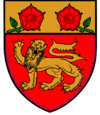Boundaries
This constituency is the parliamentary borough of Athlone. When the borough was represented in the UK Parliament, it was partly in County Westmeath and partly within County Roscommon. Although the River Shannon which runs through the town forms the historic border between County Roscommon and County Westmeath, the Local Government (Ireland) Act 1898 included much of the town entirely in Westmeath, including areas west of the river.
Athlone was described (by Samuel Lewis in 1837) as "a borough, market and post-town, and an important military station, partly in the barony of Brawney, county of Westmeath, and province of Leinster, and partly in the barony of Athlone, county of Roscommon, and province of Connaught, 12 miles (N. E. by E.) from Ballinasloe, 15¼ (S.E.by S.) from Roscommon, and 59½ (W.) from Dublin ..."
Before 1832 the limit of the borough, under its charter, was a circle of a mile and a half radius from the centre of the bridge over the River Shannon, which waterway divided the town in two. However, for electoral purposes, those boundaries were diminished in 1832 and thereafter included only the town and a very small surrounding district, comprising 485 statute acres.
The exact definition, of the boundaries of the parliamentary borough, is set out in the Parliamentary Boundaries (Ireland) Act 1832 (c. 89 2& 3 Will. 4); in the following terms.
"From the Point at which the Southern End of the Canal joins the River Shannon, along the Canal, to the Point at which the Northern End thereof joins the River Shannon; thence along the River Shannon to the Point at which the same is met by the North-western Inclosure Wall of the Barracks; thence in a straight Line to the Angle in the Hare Island Road at which the same turns Northward, and at which there are Two Gateways with Pillars opposite each other; thence in a straight Line to a Gateway with Pillars on the Ballymahon Road, about Twenty Yards to the East of the Glebe Wall; thence in a straight Line to the North-eastern Corner of the Wall of the Townland called Anchor's Bower; thence, Southward, along the Wall of Anchor's Bower to the Point at which the same meets the old Dublin Road; thence in a straight Line in the Direction of Mr. Dawson's House in Bunavally to the Point at which such straight Line cuts a small Bye Road which runs into the Dublin Road; thence along the said small Bye Road to the Point at which the same joins the Dublin Road; thence in a straight Line to the Point at which the Brideswell Bog Road is joined by a Bye Road leading thereto from the East, about Three hundred Yards from the Point at which the Brideswell Bog Road leaves the Dublin Road; thence in a straight Line in the Direction of the Chimney of Mr. Robinson's Distillery to the Point at which such straight Line cuts the River Shannon; thence along the River Shannon to the Point first described."
History
As was customary in Irish boroughs, created before the reforms of the nineteenth century, Athlone had an oligarchic constitution. The borough existed as a local government unit until it was abolished by the Municipal Corporations (Ireland) Act 1840, but the parliamentary borough was not affected by this change in administrative arrangements.
The style of the corporation was "The Sovereign, Bailiffs, Burgesses, and Freemen of the Town of Athlone". The officers were a sovereign, two bailiffs, thirteen burgesses (including the constable of the castle, who in 1837 was Viscount Castlemaine), a recorder, town-clerk, serjeant-at-mace, and billet-master; and there was a select body called the common council. The sovereign was elected by the common council from among the burgesses, annually on 29 June, and had the privilege of appointing a vice-sovereign with the approbation of the bailiffs and a majority of the burgesses. The bailiffs were elected from the freemen by the common council, on the same day as the sovereign, and were ex officio members of the council. The burgesses were elected for life from among the free men, and the freemen also for life, by the common council, of which body, according to the practice of the corporation, twelve had to be present to constitute an election. The common council were unlimited in number, but usually consisted of not more than twenty persons, including the sovereign and vice-sovereign and two bailiffs; they held their office for life, and vacancies were filled up by themselves from among the burgesses and freemen. The borough sent two representatives to the Irish parliament prior to the Union, after which it sent one to the Westminster parliament.
The right of election was vested in the burgesses and freemen. They numbered 71, in April 1831. By the Representation of the People (Ireland) Act 1832, the non-resident freemen (except those living within seven miles) were disfranchised and the right to vote was extended to the £10 householders. The registered electorate, in 1832, numbered 243.
Members of Parliament
Notes:
- a O'Connell was the candidate of a Liberal/Repealer pact.
- b Keogh belonged to a number of parties during his tenure. He was elected in 1847 as a Peelite and he was re-elected in 1852 as a Liberal pledged to form an independent opposition in Parliament. Shortly after the election he briefly joined the Independent Irish Party, but upon being appointed Solicitor-General for Ireland he was re-elected as a Liberal candidate in 1853. Until he was appointed a Judge, in 1856, Keogh remained a Liberal.
Elections
Elections in the 1870s
- The original count for the 1874 election had both candidates receiving 140 votes. However, on petition, the poll was amended to the above figures.
References
|
|---|
| History | | |
|---|
| Politics | |
|---|
| Culture | |
|---|
| Education | |
|---|
| Sport | |
|---|
